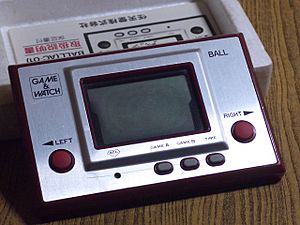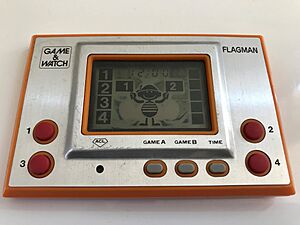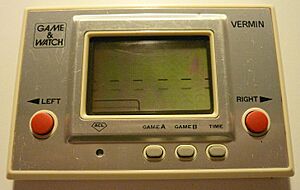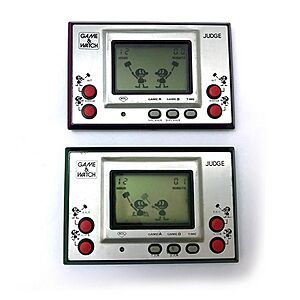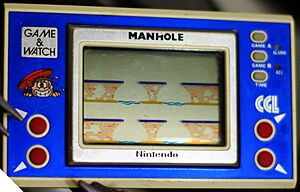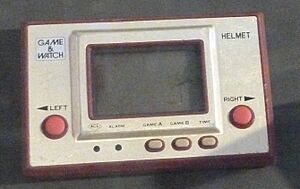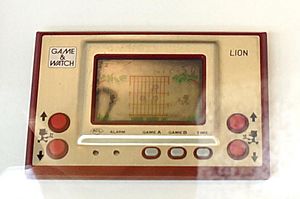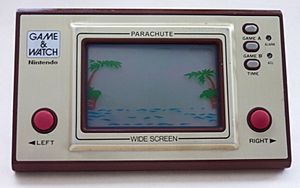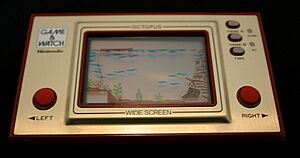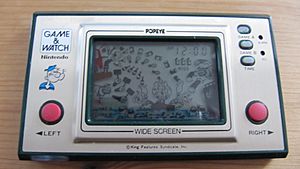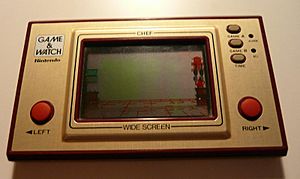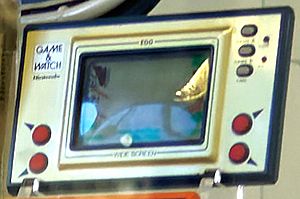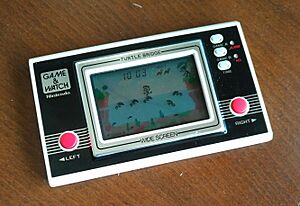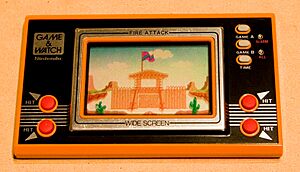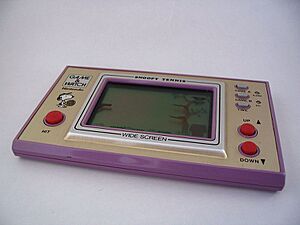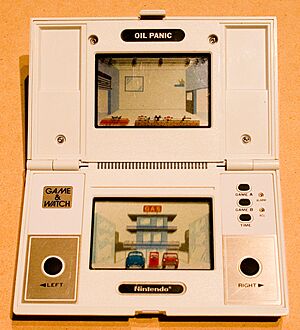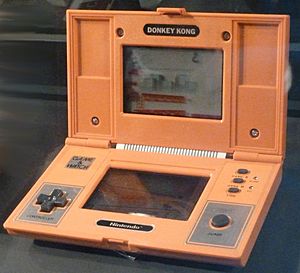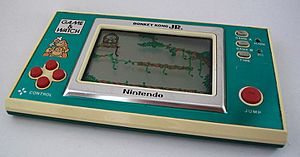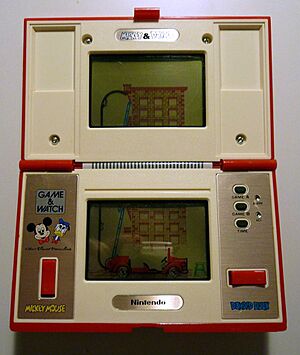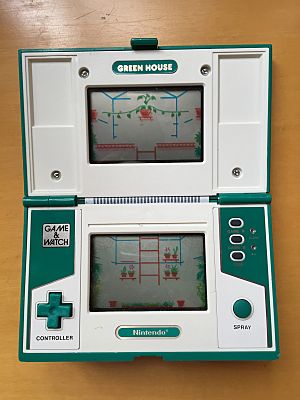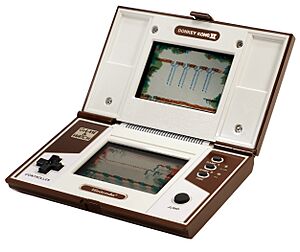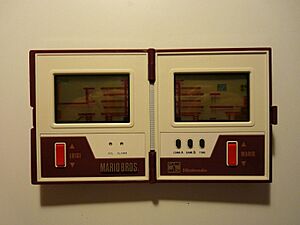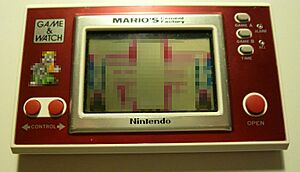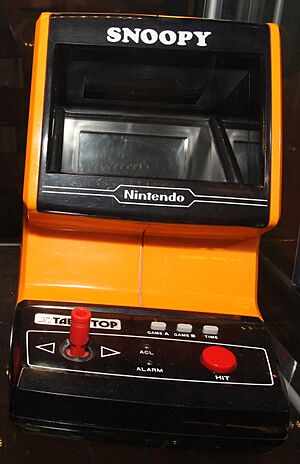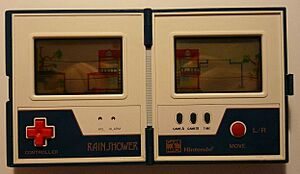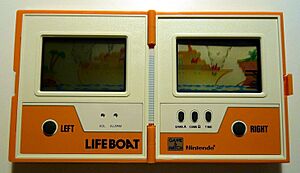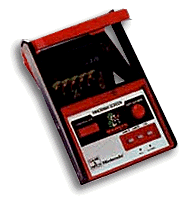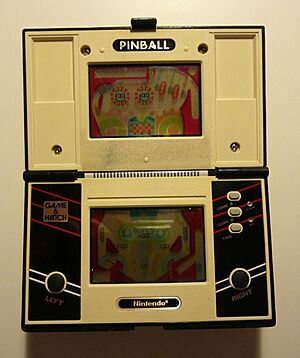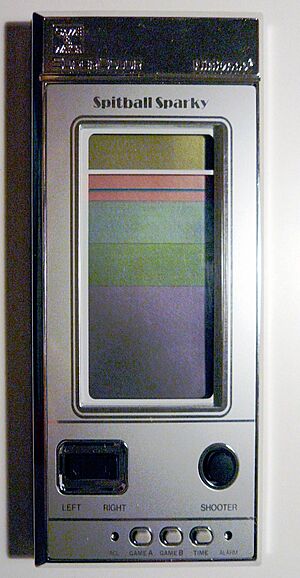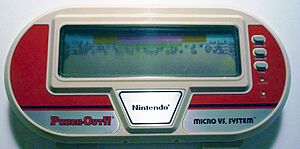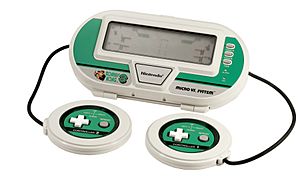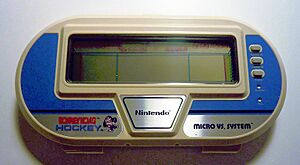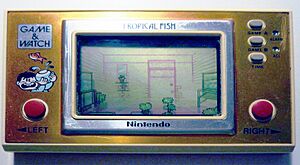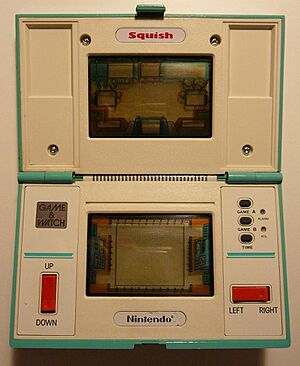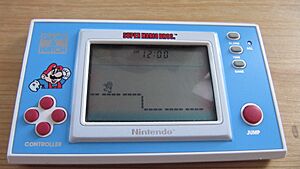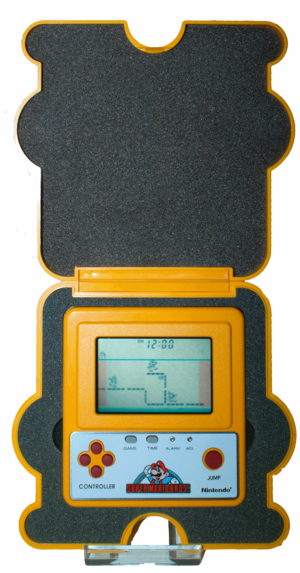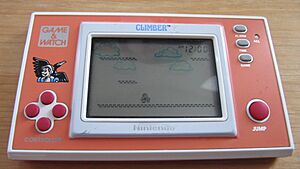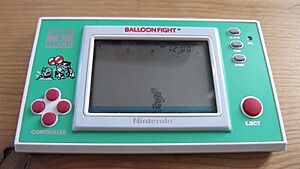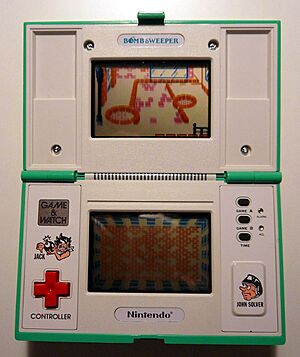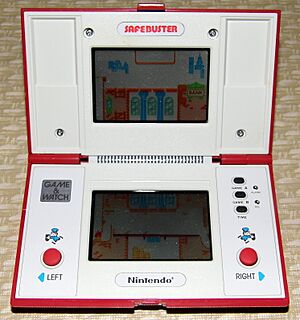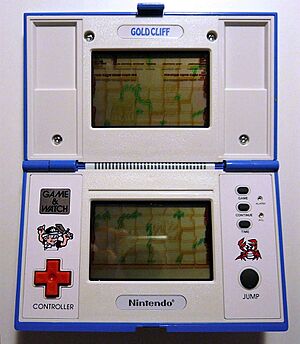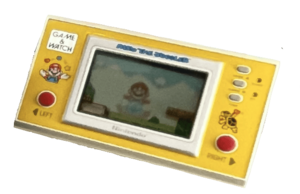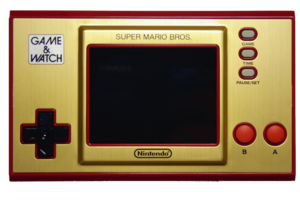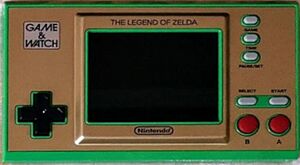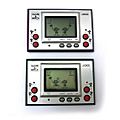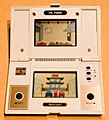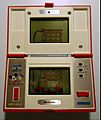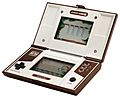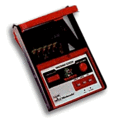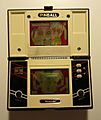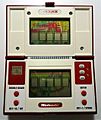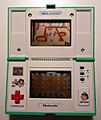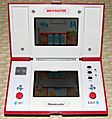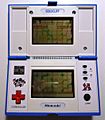- This page was last modified on 17 October 2025, at 10:18. Suggest an edit.
List of Game & Watch games facts for kids
The Game & Watch were cool handheld electronic games made by Nintendo. They were first released in 1980. Each Game & Watch device usually had just one game to play. They also had a clock, so you could use them as a watch too!
Many of these games were later brought back. You could play them on Game Boy, Game Boy Color, and Game Boy Advance in the Game & Watch Gallery series. Some even became digital games for Nintendo DSi and Nintendo 3DS.
Contents
- What are the different types of Game & Watch?
- Games
- Ball
- Flagman
- Vermin
- Fire
- Judge
- Manhole
- Helmet
- Lion
- Parachute
- Octopus
- Popeye
- Chef
- Mickey Mouse
- Egg
- Turtle Bridge
- Fire Attack
- Snoopy Tennis
- Oil Panic
- Donkey Kong
- Donkey Kong Jr.
- Mickey & Donald
- Green House
- Donkey Kong II
- Mario Bros.
- Mario's Cement Factory
- Snoopy
- Rain Shower
- Lifeboat
- Mario's Bombs Away
- Pinball
- Spitball Sparky
- Crab Grab
- Donkey Kong Circus
- Boxing
- Donkey Kong 3
- Donkey Kong Hockey
- Black Jack
- Tropical Fish
- Squish
- Super Mario Bros.
- Climber
- Balloon Fight
- Bomb Sweeper
- Safebuster
- Gold Cliff
- Zelda
- Mario the Juggler
- Super Mario Bros. 35th Anniversary Edition
- The Legend of Zelda 35th Anniversary Edition
- Images for kids
- See also
What are the different types of Game & Watch?
Nintendo made many different kinds of Game & Watch devices. Each type had a special design.
Silver Series
These were the very first Game & Watch games. They had a silver-colored casing.
- Ball (April 28, 1980)
- Flagman (June 5, 1980)
- Vermin (July 10, 1980)
- Fire (July 31, 1980)
- Judge (October 4, 1980)
Gold Series
The Gold series came next and had a gold-colored faceplate.
- Manhole (January 29, 1981)
- Helmet (February 21, 1981)
- Lion (April 29, 1981)
Wide Screen Series
These models had a bigger screen, making the games easier to see.
- Parachute (June 19, 1981)
- Octopus (July 16, 1981)
- Popeye (August 5, 1981)
- Chef (September 4, 1981)
- Mickey Mouse (October 9, 1981)
- Egg (October 14, 1981)
- Fire (December 4, 1981)
- Turtle Bridge (February 1, 1982)
- Fire Attack (March 19, 1982)
- Snoopy Tennis (April 28, 1982)
Multi Screen Series
These cool devices folded open like a book! They had two screens, which meant more complex games.
- Oil Panic (May 28, 1982)
- Donkey Kong (June 3, 1982)
- Mickey & Donald (November 12, 1982)
- Green House (December 15, 1982)
- Donkey Kong II (March 7, 1983)
- Mario Bros. (March 14, 1983)
- Rain Shower (August 9, 1983)
- Lifeboat (October 27, 1983)
- Pinball (December 5, 1983)
- Black Jack (February 15, 1985)
- Squish (April 17, 1986)
- Bomb Sweeper (June 15, 1987)
- Safebuster (January 12, 1988)
- Gold Cliff (October 19, 1988)
- Zelda (August 26, 1989)
New Wide Screen Series
These were updated versions of the Wide Screen series.
- Donkey Kong Jr. (October 26, 1982)
- Mario's Cement Factory (June 8, 1983)
- Manhole (August 23, 1983)
- Tropical Fish (July 8, 1985)
- Super Mario Bros. (March 8, 1988)
- Climber (March 8, 1988)
- Balloon Fight (March 8, 1988)
- Mario the Juggler (October 14, 1991)
Table Top Series
These were larger, colorful games that sat on a table.
- Donkey Kong Jr. (April 28, 1983)
- Mario's Cement Factory (April 28, 1983)
- Snoopy (July 5, 1983)
- Popeye (August 17, 1983)
Panorama Series
These games also sat on a table. They had a special mirror system that made the screen look bigger and more colorful.
- Snoopy (August 30, 1983)
- Popeye (August 30, 1983)
- Donkey Kong Jr. (October 4, 1983)
- Mario's Bombs Away (November 4, 1983)
- Mickey Mouse (February 28, 1984)
- Donkey Kong Circus (March 2, 1984)
Super Color Series
These were the first Game & Watch games to have a color screen.
- Spitball Sparky (February 6, 1984)
- Crab Grab (February 20, 1984)
Micro Vs. System Series
These games let two players battle each other! They had small controllers that pulled out from the sides.
- Boxing (July 31, 1984)
- Donkey Kong 3 (August 20, 1984)
- Donkey Kong Hockey (November 13, 1984)
Crystal Screen Series
These models had a clear, see-through screen.
- Super Mario Bros. (June 25, 1986)
- Climber (July 4, 1986)
- Balloon Fight (November 19, 1986)
Color Screen Series (Modern)
These are newer Game & Watch devices with full-color screens, released for special anniversaries.
- Super Mario Bros. 35th Anniversary Edition (November 13, 2020)
- The Legend of Zelda 35th Anniversary Edition (November 12, 2021)
Special Models
- Super Mario Bros. (August 1, 1987) - A very rare yellow version given as a prize.
- Ball (reissue) (April 1, 2010) - A special remake of the very first Game & Watch.
Games
Here are some of the most famous Game & Watch games:
Ball
Ball was the very first Game & Watch game. It came out in the Silver series in 1980. In this game, you control a juggler. Your job is to keep tossing two or three balls in the air. If you drop a ball, the game ends!
A special version of Ball was released in 2010 to celebrate the 30th anniversary of Game & Watch. You could get it through Club Nintendo. This new version even let you turn off the sound.
Ball has been remade many times. You can find it in Game Boy Gallery and Game & Watch Gallery 2. It was also released as a digital game for Nintendo DSi and 3DS. In the Super Smash Bros. fighting games, the character Mr. Game & Watch uses moves that look like the juggling from Ball.
Flagman
Flagman was released in the Silver series in 1980. In this game, a character named Mr. Game & Watch holds up flags with numbers. You have to remember the pattern and press the numbers in the right order. If you make a mistake or are too slow, you lose a life.
Flagman was also remade for Game Boy Gallery and Game & Watch Gallery 3. You can even play a version of it in Wario Land II and as a mini-game in WarioWare: Touched!. Like Ball, it was released for DSiWare and 3DS.
Vermin
Vermin came out in the Silver series in 1980. In this game, you need to protect your garden from moles! Moles pop out of holes in the ground, and you have to hit them with a hammer before they get into your garden.
Vermin was remade for Game Boy Gallery and Game & Watch Gallery 2. There's also a mini-game called "Vermin" in WarioWare, Inc.: Mega Microgame$!. It was released digitally for DSi and 3DS. It's also included in the special The Legend of Zelda Game & Watch device.
Fire
Fire was released in the Silver series in 1980 and later in the Wide Screen series in 1981. You control two firefighters holding a trampoline. People are jumping out of a burning building, and you must catch them and bounce them into an ambulance. If someone hits the ground, you lose a life.
This game was remade for Game & Watch Gallery, Game & Watch Gallery 3, and Game & Watch Gallery 4. It was also released as part of the Nintendo Mini Classics series. In Super Smash Bros., Mr. Game & Watch has a move called "Fire" where firemen bounce him up with a trampoline.
Judge
Judge was released in the Silver series in 1980. This game can be played by one or two players. You control characters who hold up numbers. The player with the higher number should attack, and the one with the lower number should run away. You can also take a risk and attack before the numbers are shown!
Judge was remade for Game & Watch Gallery 3 and released digitally for DSi and 3DS. Mr. Game & Watch in Super Smash Bros. has a "Judge" move where he hits opponents with a hammer, and a random number appears, changing the attack's effect.
Manhole
Manhole was the first game in the Gold series, released in 1981. It was also released in the New Wide Screen series in 1983. In this game, you need to stop people from falling into open sewers. You do this by moving a manhole cover to bridge the gaps.
The New Wide Screen version of Manhole was remade for Game Boy Gallery, Game & Watch Gallery, and Game & Watch Gallery 4. It was also released as a DSiWare game. In Warioware Gold, Manhole is an unlockable mini-game. Mr. Game & Watch in Super Smash Bros. uses a manhole cover in one of his attacks.
Helmet
Helmet was released in the Gold series in 1981. In this game, tools are falling from the sky. You need to guide your character to a house on the right side of the screen, dodging all the falling tools until the door opens.
Helmet was remade for Game & Watch Gallery 2 and released digitally for DSi and 3DS. Mr. Game & Watch in Super Smash Bros. uses a helmet in one of his attacks.
Lion
Lion was released in the Gold series in 1981. You play as a lion tamer. Your goal is to stop the lions from escaping their cage.
Lion was remade for Game & Watch Gallery 3. In Super Smash Bros., Mr. Game & Watch has an attack where he hits opponents with a chair, just like a lion tamer!
Parachute
Parachute was the first game in the Wide Screen series, released in 1981. You control a character in a boat. Your mission is to catch parachutists before they land in shark-filled waters. If you miss one, you lose a life.
Parachute was remade for Game & Watch Gallery 2, Game & Watch Gallery 4, and Game & Watch Collection 2. In Super Smash Bros., Mr. Game & Watch uses a parachute when he falls, referencing this game.
Octopus
Octopus was released in the Wide Screen series in 1981. You play as a diver trying to get treasure from a sunken ship. But watch out for the giant octopus! If the octopus touches you, you lose a life. You get points for each piece of treasure you grab.
Octopus was remade for Game & Watch Gallery, Game & Watch Gallery 4, and Game & Watch Collection 2. It was also released in the Mini Classics series. In Super Smash Bros., Mr. Game & Watch has an attack where he uses a diving helmet. His special "Final Smash" move even turns him into the octopus!
Popeye
Popeye was released in the Wide Screen series in 1981, and later in the Table Top and Panorama series in 1983. In the Wide Screen version, you control Popeye. You need to catch objects that Olive Oyl throws while avoiding attacks from Bluto. If Popeye stands in the middle of the boat, he's safe from Bluto, but he might miss Olive Oyl's throws!
The Panorama and Table Top versions are different. In those, Popeye fights Bluto to save Olive Oyl. After a few fights, she kicks him a spinach can to help him win!
Chef
Chef was released in the Wide Screen series in 1981. You play as a chef flipping food in a pan. You have to keep the food in the air. If you drop it, a mouse will steal it, and you'll get a miss. A cat might also try to mess with your food!
Chef was remade for Game & Watch Gallery 2 and Game & Watch Gallery 4. You can even unlock it in the Nintendo DS game Personal Trainer: Cooking. It was also released digitally for DSi and 3DS. In Super Smash Bros., Mr. Game & Watch has a "Chef" move where he flips food from a pan.
Mickey Mouse
Mickey Mouse was released in the Wide Screen series in 1981 and the Panorama series in 1984.
In the Wide Screen version, you control Mickey Mouse. Your job is to catch eggs rolling down slopes. If you drop an egg, it's a miss. Sometimes Minnie Mouse peeks out, and if you miss an egg then, it only counts as half a miss!
The Panorama version is very different. Mickey Mouse is performing acrobatics in a circus. You move him left and right to catch batons and avoid flaming torches.
Egg
Egg was released in the Wide Screen series in 1981. You play as a wolf waiting outside a hen house. Eggs fall out, and you have to catch them for points. If you miss an egg, you lose a life. If a hen appears and you miss, it's only half a life lost. The gameplay is very similar to the Wide Screen version of Mickey Mouse.
Egg was remade for Game & Watch Gallery 3.
Turtle Bridge
Turtle Bridge was released in the Wide Screen series in 1982. You use a line of five turtles as stepping stones to carry baggage across a river. The turtles aren't still; they dive to eat fish! You have to be careful not to be on a turtle when it dives.
Turtle Bridge was remade for Game & Watch Gallery 3. In Super Smash Bros., Mr. Game & Watch has an attack where he hits opponents with a turtle.
Fire Attack
Fire Attack was released in the Wide Screen series in 1982. You use a weapon to protect a fort from burning. Enemies throw firesticks from the top, and other characters try to light the fort with matches from the bottom. You get points for blocking the fires.
Fire Attack was remade for Game & Watch Gallery 4. In Super Smash Bros., Mr. Game & Watch has an attack where he hits opponents with a fire stick.
Snoopy Tennis
Snoopy Tennis was released in the Wide Screen series in 1982. It was also released in the Nintendo Mini Classics series. In this game, Charlie Brown hits a tennis ball towards Snoopy, and Snoopy has to hit it back. Sometimes Lucy will also hit the ball to Snoopy.
Oil Panic
Oil Panic was the first game in the Multi Screen series, released in 1982. It has two screens that fold open. You control a worker who catches oil drops from a leaking pipe in a bucket. Then, you have to empty the bucket into an oil drum. If you miss a drop or the drum, you lose a life.
Oil Panic was remade for Game & Watch Gallery and Game & Watch Collection. It's also a mini-game in WarioWare: Touched!. In Super Smash Bros., Mr. Game & Watch has a move called "Oil Panic" where he collects energy attacks in a bucket and then throws them back as oil.
Donkey Kong
Donkey Kong was released in the Multi Screen series in 1982. This game was very important because it was the first Nintendo product to use the D-pad (directional pad) for movement! This version of Donkey Kong sold 8 million units!
Donkey Kong was remade for Game & Watch Gallery 2, Game & Watch Gallery 4, and Game & Watch Collection. It was also released in the Nintendo Mini Classics series.
Donkey Kong Jr.
Donkey Kong Jr. was released in the New Wide Screen series in 1982. It also came out in the Table Top and Panorama series in 1983.
Donkey Kong Jr. was remade for Game & Watch Gallery 3 and Game & Watch Gallery 4. It was also released digitally for DSi and 3DS, and in the Nintendo Mini Classics. In Super Smash Bros., Mr. Game & Watch has an attack where he hits opponents with a key, just like in Donkey Kong Jr..
Mickey & Donald
Mickey & Donald was released in the Multi Screen series in 1982. It's a dual-screen game. The goal is to put out a fire in a three-story apartment building as fast as you can. Donald controls the hose, and Mickey runs the pump.
Green House
Green House was released in the Multi Screen series in 1982. Your goal is to protect flowers from bugs using bug spray. Worms attack the top flowers, and spiders attack the bottom ones. If three flowers are eaten, the game ends.
Green House was remade for Game & Watch Gallery 3 and Game & Watch Collection. In Super Smash Bros., Mr. Game & Watch sprays opponents with bug spray, just like in this game. This game also features Stanley the Bugman, who later appeared in Donkey Kong 3.
Donkey Kong II
Donkey Kong II was released in the Multi Screen series in 1983. It's a dual-screen game.
Donkey Kong II was remade for Game & Watch Gallery 3.
Mario Bros.
Mario Bros. was released in the Multi Screen series in 1983. This game is special because it's the first official appearance of Luigi! In this game, Mario and Luigi work in a bottling plant. They have to move boxes of bottles along conveyor belts without dropping any. If a box breaks, their supervisor gets mad!
Mario Bros. was remade for Game & Watch Gallery 3 and Game & Watch Gallery 4. In Super Smash Bros., Mr. Game & Watch has a move where he hits opponents with a package, like the boxes in this game.
Mario's Cement Factory
Mario's Cement Factory was released in the Table Top series in 1983 and the New Wide Screen series in the same year. In this game, Mario works in a cement factory. He has to move cement from the top of the factory down to trucks below. He needs to pull levers to open and close chutes, making sure the cement flows correctly. If the cement overflows, he gets a miss!
Mario's Cement Factory was remade for Game Boy Gallery and Game & Watch Gallery 4. It was also released digitally for DSi and 3DS, and in the Nintendo Mini Classics. In Super Smash Bros., Mr. Game & Watch grabs opponents in a way that looks like Mario grabbing levers in this game.
Snoopy
Snoopy was released in the Table Top series in 1983 and the Panorama series in the same year. You control Snoopy. You need to hit music notes coming from Schroeder's piano before they reach Woodstock and his friends. If you miss a note, you get a miss. Sometimes Lucy will even wake up and bother Schroeder!
Rain Shower
Rain Shower was released in the Multi Screen series in 1983. In this game, you have to move clothes on a clothesline to keep them from getting wet in the rain. In Game B, a bird might swoop down and move your clothes, making it harder!
Rain Shower was remade for Game & Watch Gallery 4.
Lifeboat
Lifeboat was released in the Multi Screen series in 1983. You control a raft in shark-filled waters. People are falling from a burning ship, and you need to catch them in your raft and bring them to safety. Your raft can hold up to four people.
Lifeboat was remade for Game & Watch Gallery 4.
Mario's Bombs Away
Mario's Bombs Away was released in the Panorama series in 1983. In this game, Mario is dressed as a soldier. He has to deliver bombs from one side of the screen to the other. He needs to avoid flaming oil spills and enemy torches. The game uses a mirror to show the action.
Mario's Bombs Away was remade for Game & Watch Gallery 4.
Pinball
Pinball was released in the Multi Screen series in 1983. This game lets you play pinball on two screens! You control flippers on both the top and bottom screens to keep the ball in play and hit bumpers.
Spitball Sparky
Spitball Sparky was the first game in the Super Color series, released in 1984. It's similar to the game Breakout. You control a character who blows a ball upwards to break blocks on the screen. If you clear blocks fast enough, you get bonus points!
Spitball Sparky was remade for Game & Watch Gallery 3. In Super Smash Bros., Mr. Game & Watch has an attack where he blows opponents upwards, just like in this game.
Crab Grab
Crab Grab was released in the Super Color series in 1984. Crabs come out from the bottom of the screen and move upwards. Your goal is to avoid being in front of a crab and push them off the screen. You get points for pushing crabs. If a crab bites you three times, the game ends.
Donkey Kong Circus
Donkey Kong Circus was released in the Panorama series in 1984. In this game, Donkey Kong is juggling pineapples while standing on a barrel. You have to help him catch the pineapples and avoid flaming torches. The gameplay is similar to the Panorama version of Mickey Mouse.
Boxing
Boxing was the first game in the Micro Vs. series, released in 1984. It's a two-player game where you can battle a friend! It's similar to the game Urban Champion.
Boxing was remade for Game & Watch Gallery 4.
Donkey Kong 3
Donkey Kong 3 was released in the Micro Vs. series in 1984.
Donkey Kong 3 was remade for Game & Watch Gallery 4.
Donkey Kong Hockey
Donkey Kong Hockey was released in the Micro Vs. series in 1984. This is another two-player game where you can play hockey with a friend!
Black Jack
Black Jack was released in the Multi Screen series in 1985. This game lets you play a simplified version of the card game blackjack. The dealer's cards are on the top screen, and your cards are on the bottom screen. You start with $500 and can bet up to $100 per hand. There's also a Game B mode where you try to stop numbers on the same digit for a reward.
Tropical Fish
Tropical Fish was released in the New Wide Screen series in 1985. You use a fishbowl to catch fish that jump out of one tank and move them into another tank. If you miss three fish, the game ends.
Tropical Fish was remade for Game & Watch Gallery 4. In Super Smash Bros., Mr. Game & Watch has an attack where he hits opponents with a fishbowl.
Squish
Squish was released in the Multi Screen series in 1986. It's a dual-screen game. It's similar to the game Devil World.
Super Mario Bros.
Super Mario Bros. was released in the Crystal Screen series in 1986 and the New Wide Screen series in 1988. In this game, Mario goes through levels to save Princess Peach, just like in the famous NES game Super Mario Bros..
A very rare yellow version of this game (YM-901-S) was given as a prize in a tournament in 1987. Only 10,000 of these were made, making it one of the rarest Game & Watch models! It was also re-released in the Nintendo Mini Classics series.
Climber
Climber was released in the Crystal Screen series in 1986 and the New Wide Screen series in 1988. It's similar to the game Ice Climber. You control a character called the Climber. Your goal is to jump through platforms in a tower, avoiding monsters, to reach the top.
Climber was remade for Game & Watch Gallery 4.
Balloon Fight
Balloon Fight was released in the Crystal Screen series in 1986 and the New Wide Screen series in 1988. This game is based on the "Balloon Trip" mode from the NES game Balloon Fight. You control a "Balloon Man" who collects balloons while avoiding sparks. Every few levels, you fight a boss!
Bomb Sweeper
Bomb Sweeper was released in the Multi Screen series in 1987. You play as John Solver, who has to find his way through a maze underground to defuse bombs. The top screen shows your boss.
Bomb Sweeper was remade for Game & Watch Gallery 4.
Safebuster
Safebuster was released in the Multi Screen series in 1988. In this game, a security guard on the bottom screen uses a tube to catch bombs thrown by a bandit on the top screen. You can hold three bombs in the tube and then dump them down a chute for points. If you miss a bomb, you lose a life.
Safebuster was remade for Game & Watch Gallery 4.
Gold Cliff
Gold Cliff was released in the Multi Screen series in 1988. You control an archaeologist, like Indiana Jones, who is looking for treasure. You have to jump across stone platforms that appear and disappear to reach a key and get into a temple. This was one of the few Game & Watch games that let you continue after losing, but you would lose some points.
Zelda
Zelda was released in the Multi Screen series in 1989. It's a dual-screen game based on The Legend of Zelda series.
Zelda was remade for Game & Watch Gallery 4 and released in the Nintendo Mini Classics.
Mario the Juggler
Mario the Juggler was the very last Game & Watch game released in the New Wide Screen series, in 1991. The gameplay is similar to the very first Game & Watch game, Ball, but with Mario juggling!
Super Mario Bros. 35th Anniversary Edition
This special edition Game & Watch was released in 2020 to celebrate Mario's 35th anniversary. It has a full-color screen! You can play the original NES versions of Super Mario Bros. and Super Mario Bros.: The Lost Levels. It also includes a new Mario-themed version of Ball and works as a clock.
The Legend of Zelda 35th Anniversary Edition
This special edition Game & Watch was released in 2021 for The Legend of Zelda's 35th anniversary. It also has a full-color screen. You can play the NES versions of The Legend of Zelda and Zelda II: The Adventure of Link. It also includes the GB version of Link's Awakening and a Zelda-themed version of Vermin. It also works as a clock and a timer.
Images for kids
See also
 In Spanish: Anexo:Juegos de Game & Watch para niños
In Spanish: Anexo:Juegos de Game & Watch para niños

